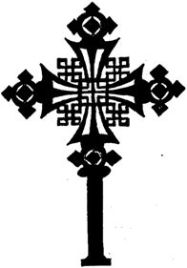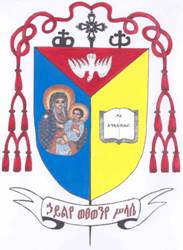The Rite and its Practice
Ethiopian Catholics have continually adhered to the Ethiopian rite and its traditions since the very foundation of the Vicariate of Abyssinia in the time of St. J. de Jacobis. As the successor to that Vicariate, the Eparchy of Adigrat continues the same practices and traditions. It is, therefore, both Catholic and genuinely Ethiopian in the practice of the faith.
When St. J. de Jacobis insisted that his priests should use the Ethiopian rite he was only being faithful to and putting into practice a much older Catholic tradition.
- Under the direction of Abba Tesfatsion the Vatican had printed in 1548 an Ethiopian missal to be used for the celebration of Mass according to the Ethiopian rite.
- After his expulsion Patriarch Mendez, S.J. wrote from Goa on 22nd February 1637 saying: "If God should ever permit me to return to Ethiopia, I would be firm in my intention of not changing anything in the rite of those people...."
- Fr. James Wemmers, a Carmelite, was consecrated Vicar Apostolic of Ethiopia, and prior to his episcopal consecration the papal brief he received, dated 3rd May 1640, stated: "By orders of His Holiness (Pope Urban VIII) Fr Wemmers and his missionaries have been given instructions not to change the Ethiopian rite...."
- Related Issues:
- Orders: In response to a doubt expressed concerning the validity of Ethiopian orders the Propagation of the Faith in 1704 accepted their validity. (cf. "On the Decision of the Holy Office on Abyssinian Orders", by J. Jones, The Month, XIX (1873), p. 452.)
- Mass Wine: The Holy See's decree of 1711 said: "It is permitted (to use for Mass) liquid extracted from raisins of dried grapes provided that by reason of its colour, odour and taste it is recognized as true wine."
- Abune Tobia, prior to his episcopal consecration on 24th June 1788, was obliged by Pope Pius VI to swear an oath that he would preserve the Ethiopian rite.
- When the Prefecture of Abyssinia became the Vicariate of Abyssinia the Papal Bull of 6th July 1847 granted the permission that "all the sacred functions (should be) according to the Abyssinian rite.
- Furthermore, the decree of 21st April 1850 stated:
- " Both Mgr. de Jacobis and his missionaries who are of the Latin rite...may carry out the sacred functions in the Abyssinian rite."
- " When celebrating in the Abyssinian rite...those who normally use unleavened bread may use leavened bread."
Later, between 1866 and 1882 there were no less than five authoritative statements permitting the use of the Abyssinian rite within the Vicariate.
- Ordinations: Mgr. de Jacobis ordained ten priests for the Vicariate of Abyssinia. Six were celibate priests and four were married prior to ordination.
- Mgr. M. Touvier, C.M. was consecrated in Rome on 3rd April 1870. During his audience with Pope Pius IX on 4th May 1870 the faculties to use the Ethiopian rite were renewed. He received permission, moreover, to celebrate a daily Low Mass. That implies that previously a Low Mass had not been celebrated neither had it been celebrated daily.
- On 30th November 1895 Pope Leo XIII published an Apostolic Letter "Orientalium dignitas Ecclesiarum":
"We deem it to be (a matter) of the greatest importance to apply (our) minds and cares to safeguarding the disciple proper to the Orientals, and to which we have always paid so much tribute. For that reason we have already given this directive to the recently founded colleges for the clerics of those nations - and we shall give the same to those to be founded (in the future) -, that they should cultivate and observe their own rites with the greatest reverence and that the students should receive knowledge and practice in them." Pope Leo XIII added: "Any Latin missionary, either secular or religious cleric, who should induce by council anybody of the Oriental (rite) to the Latin rite, besides being automatically suspended, also incurs the penalties of being deprived and excluded from holding office...."
- Cardinal Gotti in a dispatch dated 25th February 1913 officially approved the reprinting of the missal for the Ethiopian rite.
- Contemporary documents from the Magisterium of the Catholic Church: Orientalium Ecclesiarum (Vat II), The Code of Canons of the Eastern Churches and the Ecumenical Directory. These documents "are important principles for the orientation of the ecclesiastical life of every single Eastern Catholic community and are of eminent value in the celebrations of divine worship, because it is precisely thus that the Eastern Catholic and the Orthodox Churches have more integrally maintained the same heritage" (Instructions from the Congregation for the Eastern Churches, Achille Card. Silvestrini, 6th January 1996).
©Copyright by Catholic Eparchy of Adigrat. All Rights Reserved
|


